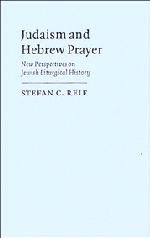Book contents
- Frontmatter
- Contents
- Preface
- 1 On Jewish liturgical research
- 2 The biblical inspiration
- 3 The early liturgy of the synagogue
- 4 Some liturgical issues in the talmudic sources
- 5 How the first Jewish prayer-book evolved
- 6 Authorities, rites and texts in the Middle Ages
- 7 From printed prayers to the spread of pietistic ones
- 8 The challenge of the modern world
- 9 A background to current developments
- Notes
- Select Bibliography
- Index of sources
- Index of prayers and rituals
- Index of names
- Index of subjects and rites
7 - From printed prayers to the spread of pietistic ones
Published online by Cambridge University Press: 05 February 2015
- Frontmatter
- Contents
- Preface
- 1 On Jewish liturgical research
- 2 The biblical inspiration
- 3 The early liturgy of the synagogue
- 4 Some liturgical issues in the talmudic sources
- 5 How the first Jewish prayer-book evolved
- 6 Authorities, rites and texts in the Middle Ages
- 7 From printed prayers to the spread of pietistic ones
- 8 The challenge of the modern world
- 9 A background to current developments
- Notes
- Select Bibliography
- Index of sources
- Index of prayers and rituals
- Index of names
- Index of subjects and rites
Summary
As with the remainder of the book, the purpose of this chapter is not to offer a detailed history of the individual prayers that make up the Jewish liturgy of today but to offer a general survey of liturgical developments that takes account of changing circumstances and outlooks, as well as of ongoing tensions, and thereby facilitates the process of understanding, more than has hitherto been possible, what is likely to have emerged when, and why. In order to be accurate and reliable, however, general surveys have to be based on particular details, however briefly presented, and it is with this in mind that the initial section of the current chapter offers some remarks about the specific accretions to the prayer-book that had occurred between the late geonic period and the first century of printing, without becoming involved in their intricate evolution. By examining such accretions and attempting to explain the overall theory behind the devotional practice, these remarks should clarify the nature of the starting-point from which the fifteenth- and sixteenth-century siddurim set out on their typographical odyssey and should thus set the tone for subsequent sections of the chapter in which demography, printing and mysticism dominate the description and analysis of developments before the Jewish emancipation and enlightenment.
- Type
- Chapter
- Information
- Judaism and Hebrew PrayerNew Perspectives on Jewish Liturgical History, pp. 207 - 255Publisher: Cambridge University PressPrint publication year: 1993



